
Boreal Trees May Grow Faster Due to Climate Change
Enhanced tree growth could significantly offset carbon emissions, but some researchers say it’s not enough to compete with forest disturbances.
In the world’s cold northern forests, climate change is altering the pace of life. Under warming temperatures, the average boreal tree will grow about 20% faster by the 2050s, a new study suggested. The estimate has researchers rethinking a long-standing question in forest ecology: How will climate change affect the boreal forest’s ability to sequester carbon?
On the one hand, rising temperatures will boost tree growth, increasing the amount of carbon being pulled out of the atmosphere. But on the other hand, climate change will bring more forest disturbances, including wildfires, droughts, and insect outbreaks, which release carbon. In the decades to come, where will the balance lie?
Forest disturbances still pose a significant threat to the forest’s ability to sequester carbon, but the picture may not be as bad as researchers previously envisioned, said ecology doctoral student Jiejie Wang with the University of New Brunswick, lead author of the new study. “The positive impacts of climate warming might help offset those negative impacts,” she said. Other researchers weren’t sure they agreed.
Growth measurements from more than 600,000 trees across Canada and the United States underlie the analysis. The data are from permanent sample plots—stands of forest that state and provincial governments have set aside to monitor forest health. Every few years, foresters record information such as the height and diameter of each tree.
“Most previous studies haven’t had data sets quite this rich,” said remote sensing expert Scott Goetz with Northern Arizona University, who was not involved in the new study. Earlier work used tree ring measurements to estimate future growth rates—a method that is biased because researchers sample only trees above a certain size, Wang said.
Using machine learning to extrapolate historical growth rates into the future, the researchers estimated that the average boreal tree will grow roughly 20% faster over the next 30 years. In general, trees in regions that are currently cool and moist will experience the biggest increases in growth rate because the length of the growing season will increase. Trees in warm regions will experience smaller increases or even decreases. Goetz and his colleagues recently performed a similar analysis (which has yet to be published) and obtained consistent results.
Still Not Enough?
The new study takes “an innovative approach,” said Northern Arizona University global change ecologist Logan Berner, who was not involved in the research. At the same time, “the picture might not quite be as rosy as they’re presenting.” His instinct is that carbon emissions from forest disturbances will significantly outweigh forest growth, even at the high rate estimated by Wang and her colleagues.
Scientists aren’t sure how climate change will influence some disturbances such as insect outbreaks and extreme weather, so estimating their relative contribution to carbon emissions requires some guesswork, Berner said. Goetz agreed. However, the suggestion that increased tree growth will make a significant dent in carbon emissions from disturbances is “a bit of a stretch,” he added.
Berner also said he wonders whether the high growth rate proposed by Wang and her colleagues might be biased because the researchers excluded sites that were recovering from disturbances and sites with unusually high mortality rates, which are likely recovering from undocumented disturbances. The strategy allowed the researchers to narrow in on the effect of climate change alone on growth rate, but it also may have raised their growth rate estimate.
Despite some wariness about how Wang and her colleagues interpreted their results, Berner said he is excited about the methods that underlie the study. The researchers broke with traditional analysis strategies by combining machine learning with a very large data set—a tactic “I think can be really powerful,” he said.
Author: Saima May Sidik
Credits: This article by Saima May Sidik, https://eos.org , is published here as part of the global journalism collaboration Covering Climate Now.
